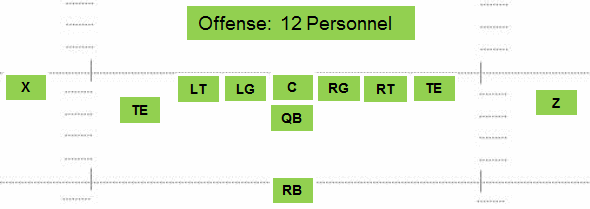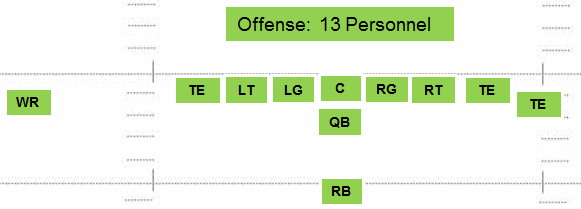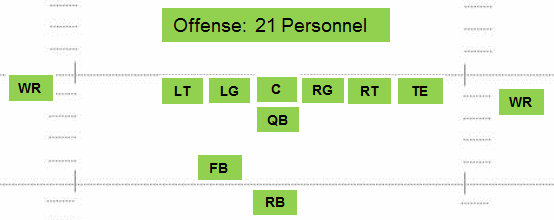Football Offensive Personnel Packages
Offensive personnel packages refer to the number of the five receiver eligible skill positions that are on the field for any given play. For example, this generally refers to how many running backs, tight ends, and/or wide receivers (if any) are in on a play.
The most common identifier for referencing personnel packages uses a two-digit number system, as referenced by the chart below.
The first of the two digits refers to the number of running backs in the personnel package and the second digit refers to the number of tight ends. The addition of both these numbers leaves a remaining balance number for the wide receivers (if any).
A formation refers to where players are positioned on the field for a play. These particular personnel groupings can be aligned to create any formation.
If you have ever heard a color analyst say something like, “They’re starting the second quarter with “11” personnel in a trips bunch formation”. This is what the analyst is referring to.
Illustrations of the various personnel packages in typical formations for those personnel packages are shown below the chart.
Offensive Personnel Packages
| Package | RB | TE | WR |
|---|---|---|---|
| "00" | 0 | 0 | 5 |
| "01" | 0 | 1 | 4 |
| "02" | 0 | 2 | 3 |
| "10" | 1 | 0 | 4 |
| "11" | 1 | 1 | 3 |
| "12" | 1 | 2 | 2 |
| "13" | 1 | 3 | 1 |
| "20" | 2 | 0 | 3 |
| "21" | 2 | 1 | 2 |
| "22" | 2 | 2 | 1 |
| "23" | 2 | 3 | 0 |

The above is an example of a “00” personnel package, which consists of zero running backs, zero tight ends, and five wide receivers. This package is usually used for obvious passing down situations. This illustration is using a five-wide formation.

The above illustration is an example of “01” personnel which consists of zero running backs, one tight end, and four wide receivers. It’s very similar to “00” personnel, but the tight end has the option to block, as well as run a route.

The above is an example of “02” personnel, which consists of zero running backs, two tight ends, and three wide receivers. This is another obvious passing down personnel package. With this personnel grouping, both tight ends have the option to stay in and block, adding protection for the QB so longer routes with the receivers can be executed.

The above is an example of “10” personnel, which consists of one running back, zero tight ends, and four wide receivers. With this personnel grouping, the running back has the option to block, run a route, or run a draw from this shotgun-bunch formation.

The above is an example of “11” personnel, which consists of one running back, one tight end, and three wide receivers. This personnel package is one of the most popular base groupings for most NFL teams.

The above is an example of “12” personnel, which consists of one running back, two tight ends, and two wide receivers. This personnel package is also on of the more popular types used by NFL teams.

The above is an example of “13” personnel, which consists of one running back, three tight ends, and one wide receiver. This personnel package is typically used in short yardage situations to give the appearance of a run play.

The above is an example of “20” personnel, which consists of two running backs, zero tight ends, and three wide receivers. This personnel package is usually run out of shotgun formation, especially when a team has two versatile running backs that can adequately block, catch, and allows the QB multiple run/pass option (RPO) scenarios.

The above is an example of “21” personnel, which consists of two running backs, one tight end, and two wide receivers. This illustration is using the weak-I pro formation with a fullback.

The above is an example of “22” personnel, which consists of two running backs, two tight ends, and one wide receiver. This personnel package is common in short yardage situations. This illustration is using the I-formation with a fullback.

The example to the left is a “23” personnel grouping, consisting of two running backs, three tight ends, and zero wide receivers. This is very similar to “22” personnel and is commonly used in short yardage situations. This example is using the “Jumbo” formation with a fullback.
